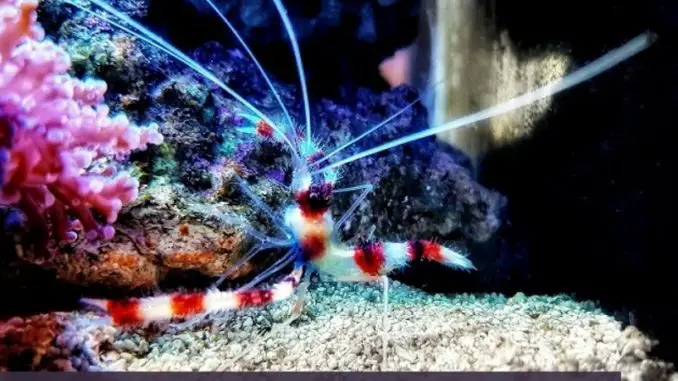
Invertebrates are a common sight in saltwater aquariums nowadays, especially reef tanks that are full of corals.
Shrimps are often overlooked when filling a tank with creatures because there are so many brightly colored fish to choose from. But sometimes shrimp can be strikingly attractive too.
The Coral Banded Shrimp is one example of this. They have a distinctive pattern with bold colors, and they are full of personality.
What’s better is that they are easy to care for. You don’t need to worry much about them as they mostly look after themselves. Therefore, they could be a good choice for beginners.
We will explain how to care for Coral Banded Shrimps, talking to you through all their preferences and needs.
See related: harlequin shrimp
TABLE OF CONTENTS
Coral Banded Shrimp Facts & Overview
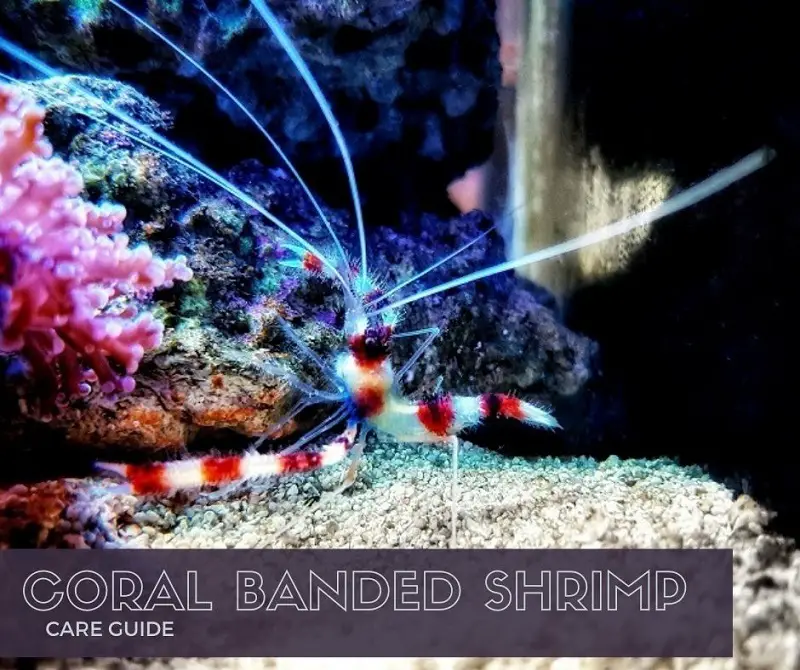
| Category | Rating |
| Care Level: | Easy |
| Temperament: | Peaceful if they are the only shrimp |
| Color: | Red and white bands |
| Lifespan: | 2-3 years |
| Size: | 2-4 inches |
| Diet: | Omnivore |
| Family: | Stenopodidae |
| Minimum Tank Size: | 20 gallons |
| Tank Set-Up: | Saltwater with lots of hiding spots |
| Compatibility: | Peaceful Community |
They are a member of the Stenopodidae family, so technically speaking, the species isn’t actually a shrimp, they’re just a shrimp-like decapod. Coral Banded Shrimps are saltwater crustaceans that have become very popular among aquarists due to their distinctive colors and patterns.
In shops, you may see them labeled as Banded Cleaner Shrimp, or even as their scientific name, Stenopus hispidus.
They’re so similar to shrimp in both appearance and behavior that you’re unlikely to notice a difference though.
Coral Banded Shrimps enjoy the warm waters in tropical environments and some temperate areas. They can be found in the Indo-Pacific, as well as the Western Atlantic from Canada all the way down to Brazil.
Saltwater Shrimps are not sold in all pet stores, and where they are, you may not find the species you want. Search around online for a reliable stock near to you.
Prices can vary dramatically depending on the stock you find. They could cost you $10-$30. This is largely based on the age/size of the shrimp and the quality of their colors.
Once bought and added to your aquarium, these crustaceans could live for 2-3 years if cared for properly.
See related: bamboo shrimp care
Typical Behavior
The temperament of Coral Banded Shrimp will vary based on their tank mates. If kept with just fish, they should live side by side peacefully, unless the fish enjoy eating shrimps as part of their diet.
Keeping them with shrimps or other crustaceans could bring out their aggressive side.
They’re territorial, so if a shrimp enters their personal space, fighting may ensue. This could result in a few lost limbs, but it is rarely fatal.
Other crustaceans, like snails, are problematic because they could be part of a Coral Banded Shrimp’s diet.
In the wild, this species acts as a cleaner for fish. They pick off parasites, which provide them with food and removes pathogens for the fish.
They are mostly nocturnal; they come out at night in search of food. When active, you’ll find them on various surfaces around the tank.
In the day they will hide away in caves. They return to the same cave each day, after claiming it as their territory.
Though they’re not shrimp, Coral Banded Shrimp molt just like all crustaceans.
Crustaceans have an exoskeleton that doesn’t grow along with the rest of them. Occasionally they must shed their old exoskeleton so that a larger one can develop. This process is called molting.
They should regrow any limbs lost through fighting during a molt too.
Look out for discarded exoskeletons on the substrate, don’t be tricked into thinking it’s a dead shrimp!
Appearance
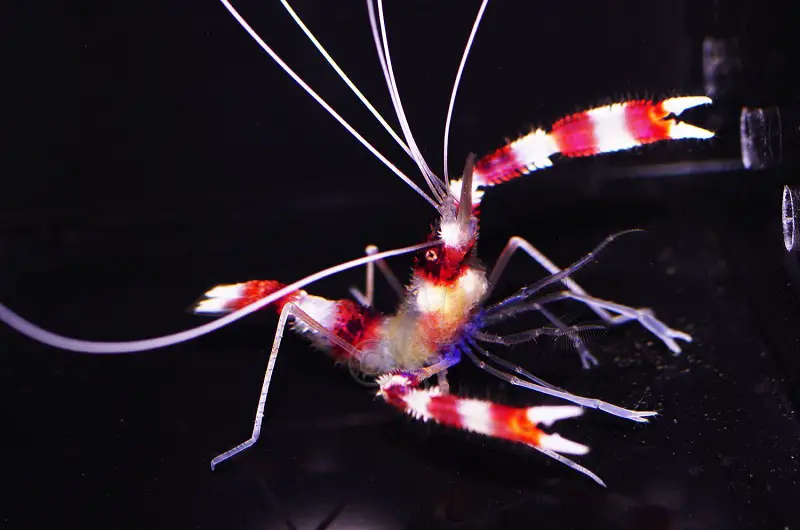
The marine environment boasts some of the most beautiful aquatic creatures, which is why many people are drawn to a saltwater setup.
Banded Coral Shrimp tend to be chosen based on their striking appearance. They have a combination of bright colors, interesting designs, and distinctive forms.
Their body and pincers are covered in a band of white and red, while their legs and antennae are solid white.
There are a couple of similar species with different designs. Stenopus scutellatus is golden, Stenopus tenuirostris is banded blue or purple, and Stenopus zanzibaricus is banded yellow.
The body is long and narrow, reaching a length of around 2-4 inches. The appendages are attached under the carapace. As a Decapod, they have ten appendages.
The first pair of appendages are the largest and have the biggest pincers. These are the ones with the characteristic pattern.
The other appendages are much smaller, though two further pairs have claws, which are smaller to match. These claws are useful for picking parasites from fish.
There are also long antennae attached to the body. These are used to gather tactile and chemical information about their environment. In other words, they are used for three senses: touch, smell, and taste.
Sometimes these antennae are waved to signal fish that might need cleaning.
There are a couple of ways to tell males and females apart. The most noticeable way is the difference in size. Males are much smaller than females.
Size can be subjective though, especially if you only have one individual with nothing to compare against.
The more reliable method is to look at the underside of their body. Here you can spot a female’s ovaries, which appear as blue/green patches. The colors will be much more pronounced after molting.
Habitat and Tank Conditions
Natural populations of Coral Banded Shrimp are fairly widespread. They can be found in the Indo-Pacific of the Western Atlantic. This means they can be found in both Australia and Brazil, which are half a world apart.
As the name suggests, these crustaceans live among corals on reefs below the intertidal zone, at a depth of up to 690 ft.
Reefs provide an array of hiding spaces for Coral Banded Shrimp as the corals are bundled up together, creating lots of crevices and caves.
Each individual finds their own secluded area and resides away from other similar species. The territory is usually 3-6 ft in diameter.
The water would be warm in these tropical regions, and alkaline.
The way to keep this species healthy, just like with all aquatic pets, is to recreate their natural environment in your tank at home.
Tank Conditions
Caves are an important component of a Coral Banded Shrimp’s tank. They will claim a cave as a territory and regularly return there, though they will hide all over the tank.
It’s easy to create cracks and crevices using decorations, rocks, and debris. You could even use corals, but this comes with risks that we’ll explain later.
Cover the bottom of the tank in the sand or fine gravel.
This species can be particularly sensitive to changes in water chemistry, so it is crucial to keep the aquarium clean. If water parameters change suddenly, the results could be fatal.
Set your heater in the range of 72-78°F to match their tropical natural habitat. The pH will need to be controlled too, keep it between 8 and 8.4.
As a saltwater species, you’ll need to maintain a salinity of 1.020-1.025 as well.
You do not need any special pieces of equipment like water or air pumps, just a good filtration system and a heater.
Standard aquarium lighting should be fine, but this may vary based on the requirements of your other inhabitants.
What Size Aquarium do they need?
The minimum tank size for Coral Banded Shrimp is 20 gallons.
These are small crustaceans, so they don’t take up much space, but they are also territorial and need their own area to stay stress-free.
As natural scavengers, they appreciate having a large tank to explore in search of food at nighttime.
The bigger the tank you can provide, the happier the shrimp will be.
How Many Can be kept per gallon?
It is best to just keep one individual. If kept together, they will start fighting over territory.
A mating pair could be kept in a 30-gallon aquarium, but multiple males would need a very large tank so that they rarely come across each other and enter each other’s territories.
Tank Mates
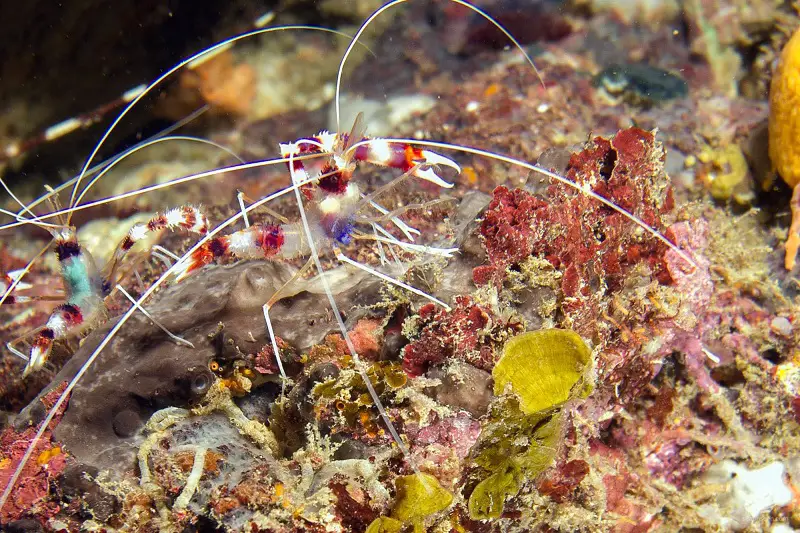
It is important to choose the right tank mates; you don’t want them, or your Coral Banded Shrimp, getting eaten.
Fish can make good tank mates. This species tends to ignore them, so the only fish to avoid are predatory ones that might eat shrimp.
This includes Eels, Lionfish, Groupers, Snappers, and Triggers.
Choose smaller, peaceful fish like clownfish, green chromis, damselfish, tangs, watchman gobys, butterflyfish, and royal grammas.
Most invertebrates should be avoided, especially slow-moving ones. Any that a Coral Banded Shrimp can catch will be eaten, so snails don’t stand a chance.
Keeping them with corals can be risky. They are known to steal food from anemones and corals, which may cause them to struggle. Some people even report them damaging anemones.
Can You Keep Banded Coral Shrimps Together?
When kept together, they often show aggression, especially between males. They can be quite territorial, which leads to fights and lost limbs.
The safest option is to keep Coral Banded Shrimps singly; they are fine living independently. A pair of one male and one female could be kept if you want to mate them, but that is a big challenge.
This species actually has the ability to identify their own kind, which isn’t common among similar invertebrates. It’s unknown how they do this, but one theory is through chemical signals.
Diet
Feeding times are easy because this crustacean is an omnivore, meaning that they can eat both meaty foods and plant matter. This gives you plenty of options to choose from when picking their food.
They naturally behave like a scavenger, so they would mostly eat meaty foods. This could be worms or other crustaceans, such as snails and small shrimp (so don’t add these to your tank). They would eat algae and detritus too though.
Coral Banded Shrimp spend much of their time acting as cleaners for fish, so parasites, fungi and damaged tissue make up a large proportion of their diet too.
The best foods that you could give them at home would be live or frozen. These contain the highest nutrient content.
Dried foods, such as flakes and pellets, are acceptable, too, but the manufacturing process removes most of the nutrients.
If you do want to use dried foods, make sure they’re not their only source of food. Always supplement the diet with live/frozen foods to provide everything they need to stay healthy.
Since they are nocturnal, they would naturally eat at night. However, they will likely learn your feeding routine.
Competition for food can be a problem. Banded Coral Shrimp move much slower than fish that might want to steal their food.
Watch carefully at feeding times to ensure that everyone is getting fed. You might need a feeding stick, to place food directly in front of your shrimp, if tankmates are stealing too much.
Care
In general, Coral Banded Shrimps are easy to care for.
Your job is to maintain the internal environment of your tank. They can be sensitive to changes in their environment, which could be fatal if the problem isn’t fixed quickly.
You should use a water testing kit each week to monitor the water parameters. You can then respond quickly if anything is going wrong. Check that all your equipment is working at the same time.
Pay attention to when your shrimp are molting. They usually hideaway to molt because the process leaves them vulnerable until their new exoskeleton develops and hardens.
Try not to move them while they molt as it may cause damage.
Once they have finished molting, remove the old exoskeleton from the tank so that it doesn’t get broken down and raise nitrate levels in the water.
Sometimes shrimps lose limbs through general injury or fighting, these should grow back during their next molt.
If you are ever adding chemicals to the water, check that they don’t contain copper. Copper is toxic to virtually all aquatic invertebrates and can very quickly lead to deaths.
The disease is uncommon among Coral Banded Shrimp; they rarely pick up pathogens as fish do. If your shrimp is looking ill, there is likely a problem with your setup.
Poor nutrition can cause illness too. Not only can it lead to starvation, but it can also hinder the development of their exoskeletons when molting, leaving them vulnerable.
We mentioned earlier that this species can easily be outcompeted for food, so keep an eye on them at feeding times.
Breeding
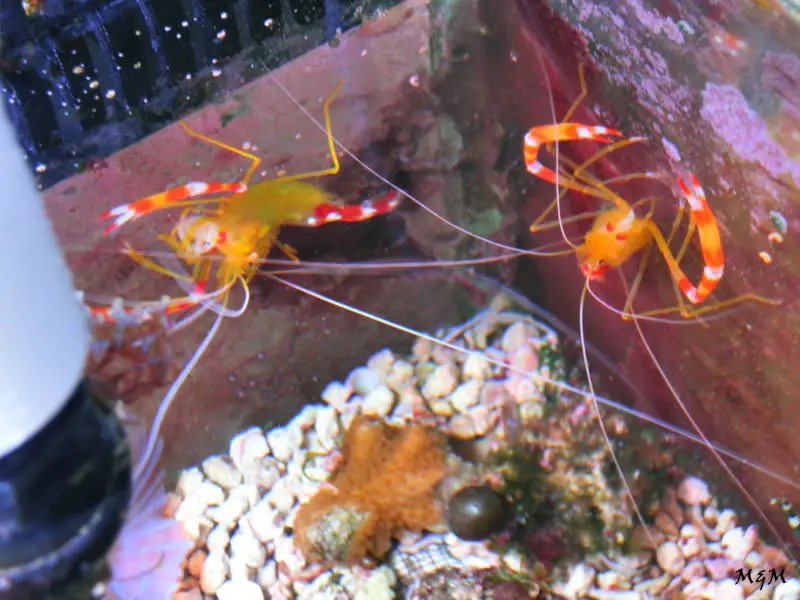
Successfully breeding and raising Coral Banded Shrimp is incredibly tough, much harder than breeding fish, so don’t be disheartened if you struggle.
Getting your shrimp to breed in the first place isn’t too difficult. If they are healthy, they should mate on their own. A clean aquarium is key, the water conditions need to be maintained at their preferred levels.
It is also essential that you have a male and a female, which can be identified by looking for green/blue ovaries on their underside.
When ready to mate, the male will start courting the female with a unique dance. The female will likely have been molted recently.
A sperm sack is transferred to the female to fertilize her eggs. These will be carried around on her legs before hatching after around 16 days.
It is very difficult to keep the larvae alive during the next couple of steps in their development.
The hatched larvae attach to the mother’s legs for six weeks before detaching and floating as plankton on the surface for a few weeks more.
There are a couple of problems that aquarists run into here.
One is that the larvae are often eaten before they get a chance to grow, so they should be separated from tank mates, including their parents.
Another problem is that the larvae get drawn into the filtration system since they are so small. A sponge filter may be able to protect them from the filter’s inlet.
After a few molts, the larvae will come down from the surface and hide away. At this point, they will eat a similar diet to their parents, after having eaten very small foods.
Are Banded Coral Shrimps Suitable for Your Aquarium?
If you’re new to saltwater aquariums and are looking for a shrimp that is easy to care for, this species could be for you.
Though not technically shrimp, they look and behave the same way. In fact, they look more attractive than most shrimps due to their bold red and white bands. This is why they’re kept by aquarists of all experience levels.
You may get frustrated if you’re trying to breed them, but they’re incredibly convenient if this isn’t your goal. The only thing to watch out for is their aggression towards other shrimps.
Coral Banded Shrimps make an excellent pairing for peaceful fish and will definitely add some interest to your setup.
Why do you love Coral Banded Shrimp? Let us know in the comments below…

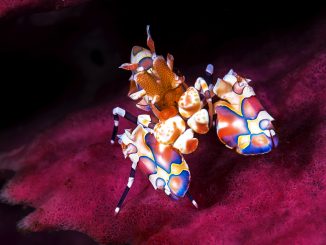
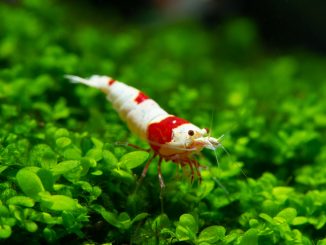
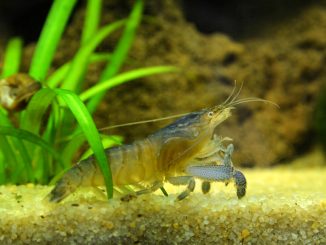
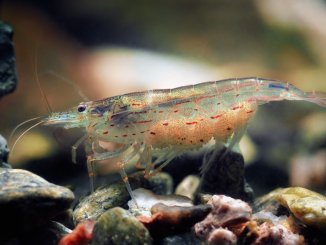
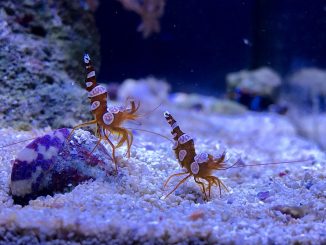
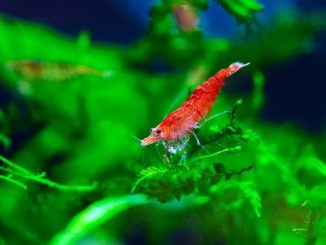

Question: Why do you love Coral Banded Shrimp? Let us know in the comments below…
Answer: Because of their unique colors and patterns and because they are easy tocare for!